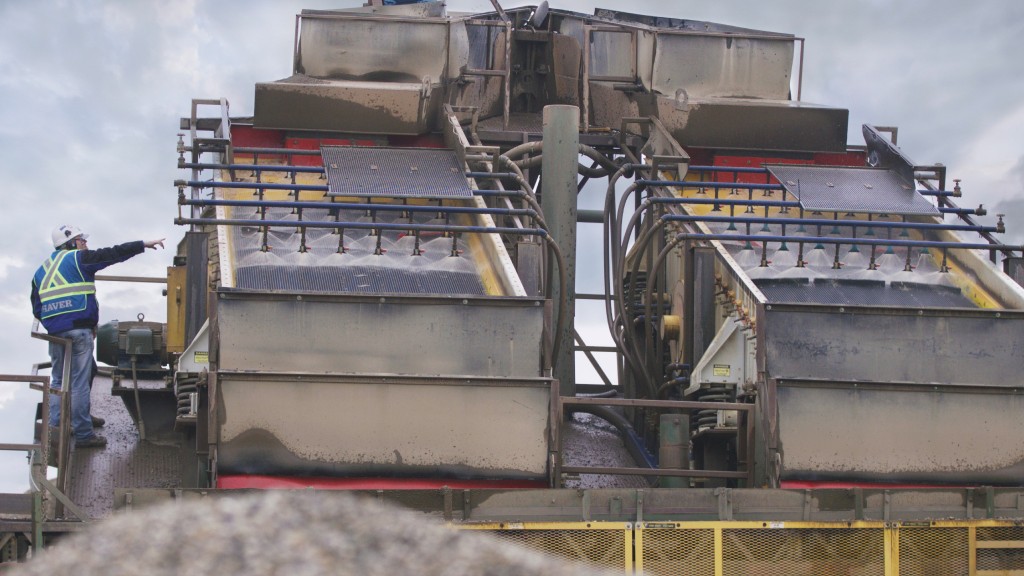
Producing the most tons per hour, ensuring materials meet specifications, and maximizing the wear life of screen media can be difficult to achieve using only one type of media. Finding the perfect balance of high wear and maximum longevity isn't always an easy task. The feed end may wear out before the discharge end, or using a full deck of a more durable type of screen media may reduce tonnage.
Many times, the solution lies not in a single "screen-all" product. Instead, each recycling application requires its own configuration of screen media. The process of choosing that mix is best accomplished through careful analysis – including diagnostic analysis – an inspection of screen media, and the vibrating screen itself, followed by a recommendation from an expert.
To help find the best media for each phase, here are a few checkpoints to increase screening productivity.
Vibration analysis
Vibration analysis systems can provide real-time, 24/7 monitoring of machine performance. The resulting data can help producers spot abnormalities the human eye cannot detect before they become costly, such as a hairline crack in the side plate or a twisting motion that will affect both screening efficiency and the wear life of your equipment. This helps minimize downtime and maintenance costs, improving overall profitability.
Inspection
A visual inspection of the vibrating screen and screen media is necessary to better understand areas for improvement. The discarded screen media pile is one of the first places to look for problem areas, such as broken wires, wear areas, pegging or blinding. Premature wear often occurs with screen media that can't handle heavy material or excessive abrasive fines. Screen media openings should be a focus when looking for wear. For example, wear is apparent if the square openings in engineered media begin to round. Types of media unsuited for the application can also result in blinding, pegging, or carryover, leading to the added cost and time commitment of rescreening. Additionally, broken screens mean costly, unscheduled change-outs.
Phases of screening
Screen media manufacturers can help evaluate how the recycled material moves through the three phases of screening – from layered to basic to sharp – to give recommendations on the best screen media for an application. Producers can customize the screen deck by choosing screen media that maximizes productivity for each phase by blending the optimal combination of open area and wear life.
The material begins its path down the screen deck during the first phase – layered screening – where the screen media should be able to handle a deep bed depth, high impact and a mix of coarse and fine particles. Heavy-duty options, such as those using polyurethane, rubber or perforated plate, can excel in withstanding high top sizes and abrasion.
Screen media with the ideal combination of wear life and open area is best for the next phase – basic screening – where most of the screening action takes place. Hybrid screen media, for example, pairs polyurethane's durability with an open area similar to woven wire and is often a good choice for the middle of the deck.
Sharp screening takes place at the discharge end and requires maximum open area to allow any remaining undersized particles to fall through and for near-sized material to pass, preventing contamination. Woven wire or self-cleaning media provide the best open area in this phase.
Screen media selection
Screen media inspections provide the information required to recommend the best type of media for each phase of screening. A certified screen media representative will work with operations to decide what combination of media will provide the most efficient solution for each phase. This often means using a blend of different types of screen media to achieve the best combination of wear life with an open area.
Implementation
The last step is to start switching out screen media. Changing out one section at a time – such as beginning at the feed end of the top deck – helps pinpoint where performance improvements are being made.
Careful selection and the correct blend of screen media can mean thousands of dollars in savings for a recycling plant. For best results, it is recommended to work with a reputable screen media manufacturer or certified dealer for informed advice.
Steve Fair is the Tyler engineered media manager at Haver & Boecker Niagara
Company info
225 Ontario St.
St. Catharines, ON
CA, L2R 7B6
Website:
haverniagara.com
Phone number:
1-905-688-2644



